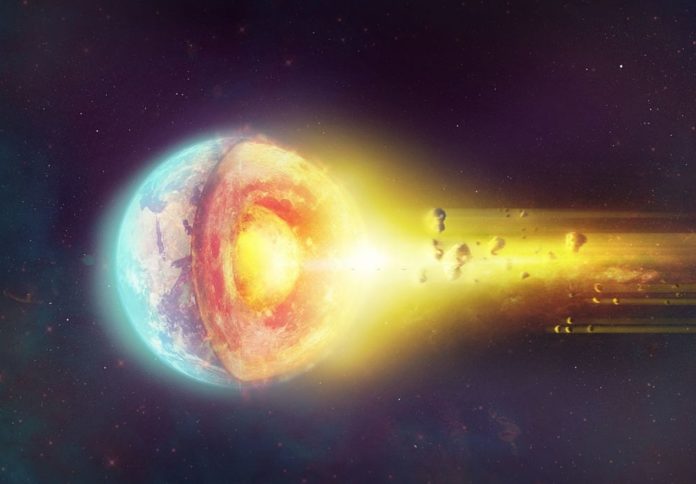Scientists descend to the earth’s core, where seismic waves slow to a crawl, after passing through the crust and mantle.
Let’s travel deep into the Earth’s interior, almost to the core, through the crust and mantle.
There are zones near the core where seismic waves slow to a crawl.
The University of Utah’s recent research reveals that these cryptic and descriptively termed ultra-low velocity zones are unexpectedly layered.
Modeling shows that some of these zones may be remains of the processes that shaped the early Earth—remnants of incomplete mixing, similar to clumps of flour in the bottom of a batter bowl.

“Of all of the features we know about in the deep mantle, ultra-low velocity zones represent what are probably the most extreme,” said professor Michael S. Thorne.
“Indeed, these are some of the most extreme features found anywhere in the planet.”
Into the mantle
Let’s have a look at how the Earth’s interior is organized. The crust is a small layer of solid rock on which we live. The mantle is the layer of the planet that lies between the crust and the iron-nickel core at its core. It’s not an ocean of lava; rather, it’s a solid rock that’s hot and has the potential to move, which causes plate tectonics near the surface.
How are we supposed to know what’s going on in the mantle and core? Waves of the earth’s crust. Scientists on the ground can measure how and when the waves arrive at monitoring stations throughout the world as they ripple through the Earth following an earthquake.
They can estimate how the waves were reflected and deflected by structures within the Earth, including layers of varying densities, using those observations.
That’s partly how we figure out where the boundaries of the crust, mantle, and core are – and what they’re comprised of.
At the bottom of the mantle, atop the liquid metal outer core, are ultra-low velocity zones. Seismic waves decelerate by up to half in certain places, while density rises by a third.
Initially, scientists considered that these zones were regions where the mantle was mostly melted, and that they could be the source of magma for “hot spot” volcanic regions like Iceland.
“But most of the things we call ultra-low velocity zones don’t appear to be located beneath hot spot volcanoes,” Thorne added, “so that cannot be the whole story.”
So Thorne, postdoctoral scholar Surya Pachhai, and colleagues from the Australian National University, Arizona State University, and the University of Calgary set out to investigate another possibility: that the ultra-low velocity zones are made up of different rocks than the rest of the mantle, and that their composition may date back to the early Earth.
Perhaps ultra-low velocity zones are clumps of iron oxide, which we see as rust on the surface but can act as a metal in the deep mantle, according to Thorne. If this is the case, pockets of iron oxide just outside the core could have an impact on the Earth’s magnetic field, which is formed just below the surface.
“The physical properties of ultra-low velocity zones are linked to their origin,” Pachhai added, “which in turn provides important information about the thermal and chemical status, evolution and dynamics of Earth’s lowermost mantle—an essential part of mantle convection that drives plate tectonics.”
Reverse-engineering seismic waves
It was important to get a clear picture, so the researchers looked at very slow-moving parts of the Coral Sea between Australia and New Zealand. The profusion of earthquakes in the area provides a high-resolution seismic picture of the core-mantle boundary, making it an attractive location. The goal was that high-resolution observations would provide light on the assembly of ultra-low velocity zones.
But capturing a seismic image of something through over 1800 miles of crust and mantle is difficult. It’s also not always certain—a large layer of low-velocity material could reflect seismic waves in the same way as a small layer of even lower-velocity material.
In this case, the team used a reverse-engineering method.
“We can create a model of the Earth that includes ultra-low wave speed reductions,” Pachhai said, “and then run a computer simulation that tells us what the seismic waveforms would look like if that is what the Earth actually looked like. Our next step is to compare those predicted recordings with the recordings that we actually have.”
The process, known as “Bayesian inversion,” gives a mathematically robust interior model with a good knowledge of the uncertainties and trade-offs of different assumptions in the model.
One of the questions the researchers hoped to solve was whether ultra-low velocity zones have internal structures, such as layers. According to the models, the answer is that layers are extremely likely. This is significant because it demonstrates the path to comprehending how these zones came to be.
“To our knowledge this is the first study using such a Bayesian approach at this level of detail to investigate ultra-low velocity zones,” Pachhai added, “and it is also the first study to demonstrate strong layering within an ultra-low velocity zone.”
Looking back at the origins of the planet
What does it mean that there are likely layers?
It’s possible that a Mars-sized planetoid slammed into Earth’s early mantle more than four billion years ago, when dense iron was sinking to the core and lighter materials were floating up into the mantle. It’s possible that the impact threw debris into Earth’s orbit, which later produced the Moon. It also greatly increased the temperature of the Earth, as one might expect from two planets colliding.
“As a result, a large body of molten material, known as a magma ocean, formed,” Pachhai said. The “ocean” would have consisted of rock, gases and crystals suspended in the magma.
As it cooled, the ocean would have sorted itself out, with dense minerals sinking and depositing on the mantle’s bottom.
As the mantle churned and convected over billions of years, the dense layer would have been squeezed into small patches, resulting in the layered ultra-low velocity zones we witness today.
“So the primary and most surprising finding is that the ultra-low velocity zones are not homogenous but contain strong heterogeneities (structural and compositional variations) within them,” according to Pachhai. “This finding changes our view on the origin and dynamics of ultra-low velocity zones. We found that this type of ultra-low velocity zone can be explained by chemical heterogeneities created at the very beginning of the Earth’s history and that they are still not well mixed after 4.5 billion years of mantle convection.”
Not the final word
The study offers some evidence for the origins of some ultra-low velocity zones, but there is also evidence to imply that others, such as melting of ocean crust falling back into the mantle, have different origins. However, if some ultra-low velocity zones represent remnants from the early Earth, they preserve some of the planet’s history that would otherwise be lost.
“Therefore, our discovery provides a tool to understand the initial thermal and chemical status of Earth’s mantle,” Pachhai concluded, “and their long-term evolution.”
Source: 10.1038/s41561-021-00871-5
Image Credit: Getty
You were reading: Study finds the most extreme features of Earth’s lowermost mantle
